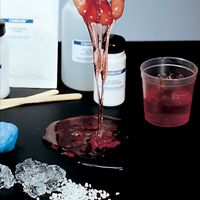My Cart
Your Shopping Cart is currently empty. Use Quick Order or Search to quickly add items to your order!
By Bruce Wilson
Product Manager, Chemistry

Conduct this activity as part of your comparison of physical and chemical changes. The experiment also highlights the effect of chemical structure on physical properties. In a remarkable physical change, each of 2 polymers absorbs several hundred times its own weight in water. When treated with sodium chloride, the hydrated polymer then loses water by diffusion. Although each polymer absorbs a huge amount of water, one absorbs much faster than the other. The dramatic difference in their rate of absorption is due to a small difference in their chemical structure.
No special safety precautions are needed when using these materials.
Super water-absorbing polymers are polymers that absorb several hundred times their own weight in water. The structure of these polymers accounts for their water-absorbing capacity.
The polymers consist of long strands of molecules covalently bonded (or cross-linked) together. The strands form hydrogen bonds with water, while the cross-links prevent the polymer from dissolving in the water. Depending on the precise structure of the polymer, the process may occur quickly or slowly. Two common super water-absorbing polymers are sodium polyacrylate and polyacrylamide.
Sodium polyacrylate consists of repeating units of the monomer –CH2CH(CO2Na)–. The sodium ion dissociates in water, leaving 2 charged particles—a free sodium cation and a carboxylate (CO2–) ion—attached to the strand. These ions attract water into the polymer by diffusion. The polymer absorbs water within a few seconds to form slush. Due to its rapid and large water-absorbency (and its harmlessness), sodium polyacrylate is used as the absorbent material in diapers.
Polyacrylamide consists of repeating units of the monomer –CH2CH(CONH2)–. The nitrogen forms hydrogen bonds with water molecules. The process is slow, usually 24 hours for a crystal of polyacrylamide to hydrate fully and form a clear, colorless cube. Because this cube consists almost entirely of water, its refractive index is nearly the same as water’s, making it nearly invisible in water. Polyacrylamide releases water slowly and finds wide use as a soil amendment in drought-prone and potentially erosive areas as well as in potting soils.
In addition to showcasing the fascinating properties of the 2 polymers, this experiment illustrates physical change. The polymers’ absorption of water is a physical change. Their chemical structure does not change, nor does the water react. When sodium chloride is added to the hydrated polymer, water diffuses out, another example of physical change.
Although the structures of the large molecules of sodium polyacrylate and polyacrylamide differ by only a few atoms, the compounds differ conspicuously in the rate at which they absorb water. This observation reinforces the concept that a small alteration in chemical structure of a substance may lead to a new substance with significantly different properties.